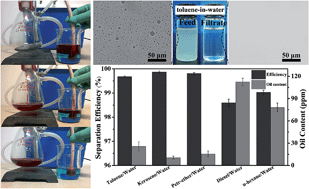Robust superhydrophobic attapulgite coated polyurethane sponge for efficient immiscible oil/water mixture and emulsion separation†
Abstract
Separation of oil/water mixtures has become an increasingly important subject worldwide because of frequent oil spill incidents and industrial oily wastewater. The filter materials for the mixtures separation need to collect first and then filter, which is energy-intensive and cumbersome. Utilization of adsorbents appears to be an economical and direct way for mixture disposal. In this study, the superhydrophobic polyurethane (PU) sponge is fabricated by coating superhydrophobic attapulgite (APT) onto its skeleton surface. The coated PU sponges exhibit robust superhydrophobicity and high adsorption capability under a series of harsh conditions, which are used for the separation of mixtures of oil and various corrosive solutions and hot water. Moreover, the coated PU sponges can selectively adsorb oils from mixtures under extreme and harsh turbulent conditions. Furthermore, the coated PU sponge connected to a vacuum system could remove up to 3200 times its self-weight in kerosene within 20 s under a vacuum degree of about 30 kPa. More importantly, the coated PU sponges can separate tiny oil droplets from surfactant-stabilized oil-in-water emulsions with a separation efficiency of over 99.87% by employing a compression and agitation procedure. All of these characteristics make the coated PU sponge a promising adsorbent for realizing oil and organic pollutant removal in realistic aquatic environments.


 Please wait while we load your content...
Please wait while we load your content...